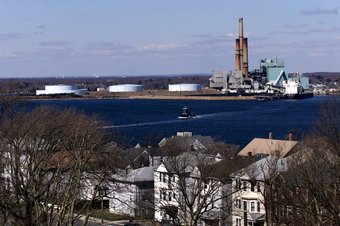Local group compiles country’s top greenhouse gas polluters
By Doug Struck
Globe Correspondent
Want to know who’s killing the planet? A research group at the University of Massachusetts Amherst has pulled together a nifty list called “The Greenhouse 100” of the top climate polluters in the country.
No surprise: the list is dominated by major power companies, primarily those that create electricity from burning coal and other fossil fuels. What is intriguing is the massive amounts of greenhouse gases they produce. The top three power companies alone produce more than five percent of all of the greenhouse gases emitted in the country.
 “It was pretty striking. It means if you could do something about their emissions, you could make a significant dent in the problem,” said James K. Boyce, an economics professor and director of the environment program at thePolitical Economy Research Institute at UM Amherst.
“It was pretty striking. It means if you could do something about their emissions, you could make a significant dent in the problem,” said James K. Boyce, an economics professor and director of the environment program at thePolitical Economy Research Institute at UM Amherst.
The list also underscores a strategic reality: to reduce the runaway growth in greenhouse gases, which already promises to wreak major changes on our planet, we must make a major industrial transformation to switch off electric plants that burn fossil fuel. Changing consumer behavior by conservation or efficiency will not do the trick.
“If you don’t address the power plants, you are really missing the elephant in the room,” Boyce said in a telephone interview.
Boyce’s group tapped into information collected by the Environmental Protection Agency on greenhouse gas pollution by each major emitting facility in 2011. Then the group traced the ownership of the facilities, and added up the collective greenhouse gas responsibility of each corporate owner.
So the number one climate change polluter, according to the study, is American Electric Power, which has 36 facilities—most of them power stations—in nine Midwest and Southwest states. Duke Energy is second on the list, and Southern Company is third.
The federal government, largely owing to its size, is fourth on the list. Included in the government’s major polluting facilities is Hanscom Air Base near Bedford. Because only 11 percent of Massachusetts Power comes from coal-burning plants – most electricity is from natural gas, with help from nuclear power and Quebec hydropower– the state has relatively few facilities on the list.
“Compared to places like Ohio, Pennsylvania, West Virginia, Georgia… Massachusetts is a relatively clean state. Certainly we do better than most,” said Boyce. That is of limited consolation: the particulates emitted by coal plants affect the local population, but greenhouse gases contribute to a global problem.
Boyce said the research institute decided to compile the list to try to make useful the mountain of data collected by the EPA, most of which is tucked away on inaccessible databases that are of little help to the public.
“We thought that in terms of the debate over responsibility for greenhouse gas emissions and climate change, it’s important for the public to have a clear sense of who were the main actors, what are the main sources of emissions,” he said. “This can be useful for socially responsible investment community, for regulators, for consumers.”
Massachusetts facilities on the list are Brayton Point and Salem Harbor coal power plants owned by Dominion Resources; oil and natural gas plants in Cambridge and Sandwich owned by Genon Energy; oil and natural gas plants in Medway, Charlestown and Weymouth owned by Exelon Corp.; five landfills or waste disposal plants owned by Waste Management Inc.; small plants in Milford, Bellingham, Blackstone, Everett, and Holyoke owned by IPR-GDF Suez North America; and five landfills owned by Republic Services Inc.
